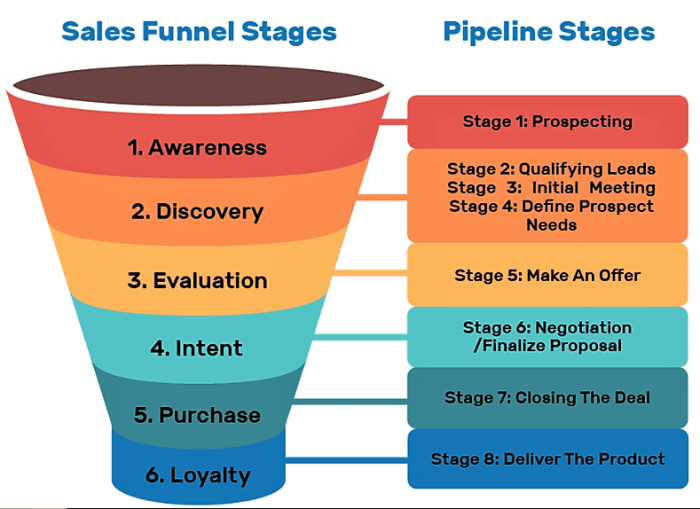Understanding the Sales Pipeline dives into the essential strategies businesses need to boost their revenue and sales performance. From lead generation to deal closure, this overview provides valuable insights to enhance your sales process.
Importance of the Sales Pipeline

Understanding the sales pipeline is essential for businesses as it provides a structured approach to managing leads, tracking progress, and ultimately increasing sales. By having a clear view of where each prospect is in the sales process, companies can make informed decisions and optimize their strategies for better results.
Impact on Revenue Growth
A well-defined sales pipeline can have a significant impact on revenue growth. By effectively managing leads and opportunities, businesses can ensure that no potential sale slips through the cracks. This leads to a higher conversion rate and ultimately increased revenue. Additionally, a streamlined sales process allows sales teams to focus their efforts on high-quality leads, leading to more successful conversions and higher revenue numbers.
Improving Forecasting Accuracy
Having a well-defined sales pipeline also improves forecasting accuracy. By tracking leads at each stage of the sales process, businesses can gather valuable data on conversion rates, average deal size, and sales cycle length. This data can then be used to make more accurate predictions about future sales performance, allowing companies to set realistic targets and allocate resources effectively.
Stages of the Sales Pipeline: Understanding The Sales Pipeline

In a typical sales pipeline, there are several key stages that a potential customer goes through before closing a deal. These stages help sales teams track and manage leads effectively, ultimately leading to successful conversions.
Lead Generation
- During this stage, leads are identified and generated through various marketing strategies such as cold calling, email campaigns, social media, and networking events.
- It is crucial to qualify these leads to ensure they align with the target customer profile and have the potential to convert into paying customers.
Prospecting
- Once leads are generated, the next stage involves prospecting, where sales reps reach out to these leads to gather more information and assess their interest in the product or service.
- Effective prospecting involves personalized communication and building rapport with potential customers to move them further down the pipeline.
Qualification
- In this stage, leads are further evaluated to determine their level of interest, budget, authority, and need for the product or service.
- Qualified leads are more likely to progress to the next stage of the pipeline, while unqualified leads may be nurtured for future opportunities.
Proposal and Presentation
- Once a lead is qualified, sales reps create a tailored proposal or presentation that addresses the specific needs and pain points of the prospect.
- This stage focuses on showcasing the value proposition of the product or service and differentiating it from competitors.
Closing the Deal
- The final stage of the sales pipeline involves negotiations, handling objections, and ultimately closing the deal by securing a purchase agreement or contract.
- Successful closing requires effective communication, understanding customer needs, and addressing any concerns to ensure a smooth transition to the onboarding process.
Key Metrics to Track in the Sales Pipeline
Tracking key metrics in the sales pipeline is crucial for optimizing the sales process and improving performance. By monitoring metrics like conversion rates, sales velocity, and win rates, businesses can make data-driven decisions to enhance their sales strategies.
Conversion Rates
- Conversion rates measure the percentage of leads that successfully convert into customers.
- Tracking conversion rates helps in identifying areas of improvement in the sales process, such as lead quality or sales pitch effectiveness.
- Improving conversion rates can lead to increased revenue and profitability for the business.
Sales Velocity
- Sales velocity measures the speed at which leads move through the sales pipeline and convert into customers.
- Monitoring sales velocity can help businesses forecast revenue and identify bottlenecks in the sales process that need to be addressed.
- Increasing sales velocity can result in shorter sales cycles and higher revenue generation.
Win Rates, Understanding the Sales Pipeline
- Win rates indicate the percentage of deals won compared to the total number of deals pursued.
- Tracking win rates allows businesses to assess the effectiveness of their sales team and strategies in closing deals.
- Improving win rates can lead to a more efficient sales process and higher overall revenue for the business.
Sales Pipeline Management Tools
In today’s fast-paced business world, managing the sales pipeline efficiently is crucial for the success of any company. This is where Customer Relationship Management (CRM) software and other tools come into play, providing organizations with the necessary resources to streamline their sales processes and drive revenue growth.
Popular CRM Software and Tools
- Salesforce: One of the most widely used CRM platforms, Salesforce offers a comprehensive set of features for managing sales pipelines, including lead management, opportunity tracking, and forecasting. It is suitable for businesses of all sizes, from small startups to large enterprises.
- HubSpot CRM: HubSpot’s CRM tool is known for its user-friendly interface and robust automation capabilities. It is ideal for small to mid-sized businesses looking to simplify their sales pipeline management processes.
- Zoho CRM: Zoho CRM is a cost-effective solution that caters to businesses of all sizes. It offers features such as lead management, contact management, and sales forecasting, making it a versatile option for sales teams.
Automation in Sales Pipeline Management
Automation plays a key role in streamlining sales pipeline management processes, allowing sales teams to focus on building relationships and closing deals. By leveraging automation tools within CRM software, businesses can automate repetitive tasks, send personalized follow-up emails, and track customer interactions more efficiently.
Overall, choosing the right CRM software and tools for sales pipeline management is essential for maximizing sales productivity and driving growth. Whether you opt for Salesforce, HubSpot CRM, Zoho CRM, or any other platform, be sure to consider your business size and specific needs to make the most out of these tools.
